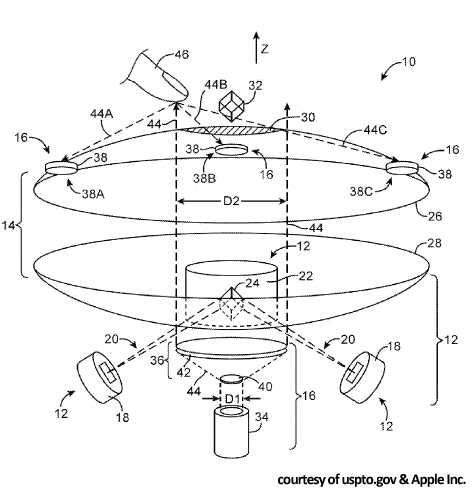A patent application from Apple Inc. (NASDAQ:AAPL) was published today by the U.S. Patent & Trademark Office (USPTO), and describes a 3D mid-air image projection system straight out of science fiction. Countless sci-fi films, starting perhaps with “Star Wars,” have included “holograms,” or three-dimensional images projected into the air itself, rather than onto a projection medium. If Apple’s patent application is to be believed, the Cupertino firm has devised a method of actually creating images of this kind.
The patent application, #20140111479, is entitled “Interactive Three-Dimensional Display System.” Though the technical details are not heavily touched upon, it seems that lasers will be used to create a three-dimensional image inside a projection medium, such as a large non-linear crystal or an alternative. Parabolic mirrors and lenses are then used to project this image “into mid-air,” creating an “optical illusion” that hovers in space over the 3D display device.

Nature provides examples of similar phenomena, of which the mirage is the most famous example. Although mirages are images that are “projected” onto the air itself, they require a strong temperature differential between two air masses in order to occur. They are also usually seen from a remote distance and may have a wavering quality due to hot air currents rippling through them. None of these factors would be present with Apple’s (AAPL) device, making it all the more amazing.
Up to this point, the closest to 3D projection that technology has achieved is filling the air with a thin fog of reflective vapor, too slight for the human eye to see but enough for projected light to reflect from, forming an image. This method is poor at creating a lasting 3D image, however, because the fog can easily disperse, be blown around by drafts or the movement of nearby people, and so on.
The new patent application also includes information on using sensors to detect user movements relative to the projected image, via either visible light or infrared. In this way, a viewer could interact with the 3D image, causing it to change, or enabling its use as a control interface. Indeed, the application refers to projecting an illusory user interface (UI) incorporating some combination of knobs, buttons, keyboards, scroll wheels, and so on into the air, then taking command inputs by sensing the user’s interaction with this illusion.
The inventors of record are Christoph H. Krah and Marduke Yousefpor, whose names are scarcely household words. However, they may win renown in the records of technological history if their invention ever sees the light of day and proves to be a workable method of projecting a solid-looking interactive 3D image into mid-air.




